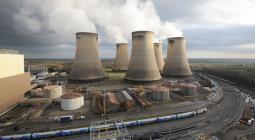Δεν χρειάζονται εξωτικές λύσεις απορρόφησης άνθρακα για να κρατηθεί η άνοδος της θερμοκρασίας κάτω από 1,5ο C.

EXOTIC CARBON CAPTURE TECHNIQUES PROP UP FOSSIL INTERESTS, AREN’T NEEDED TO HIT 1.5°C, NEW STUDY ASSERTS
The urgency and scope of the climate crisis are being needlessly exploited to drive fringe ideas like carbon dioxide removal (CDR) and solar radiation management (SRM) from the margins to the mainstream, according to a hard-hitting report issued last week by the Washington-based Center for International Environmental Law and Berlin’s Heinrich Böell Foundation.
“Almost all geoengineering proposals serve to entrench and benefit fossil fuel interests rather than solve the climate crisis,” the report concludes. “By promoting the development of new fossil fuels and costly fossil infrastructure, by diverting resources away from proven mitigation strategies to costly boondoggles, and by sustaining the myth that meaningful climate action can be safely delayed or narrowly constrained, geoengineering threatens to undermine real solutions at the time when they are most urgently needed.”
In a joint release, the two organizations contend that:
- Enhanced oil recovery would be the ultimate beneficiary of 85% of U.S. subsidies for carbon capture and storage (CCS) and Direct Air Capture (DAC) technologies.
- CCS proponents believe the technology could increase coal consumption by 40% and lead to the extraction of 923 million additional barrels of oil, in the U.S. alone, by 2040.
- Direct Air Capture, notwithstanding the glowing media it’s received in recent months, is a highly energy-intensive technology that “will be used primarily to produce hydrocarbon fuels that will themselves be burned, resulting in either net carbon emissions or massive diversions of renewable energy for uncertain benefits while simultaneously slowing the transition from internal combustion engines.”
- Fossil industry advocates “openly believe CCS and CDR are essential to save coal, ensure the future of oil and gas, and ‘unlock’ unburnable carbon.”
- Oil companies, in turn, are relying on carbon dioxide removal to justify continued heavy reliance on oil and gas at least until 2100, despite the IPCC’s 2030 deadline to reduce global greenhouse gas emissions by 45%.
- Proponents of one of the most controversial geoengineering methods, Solar Radiation Management, have for decades “cited the potential to delay or minimize climate mitigation measures as a primary justification for its use.” They assume countries “will inject sulphate or other aerosols into the skies for decades to centuries to come—and deploy CDR to bring emissions back down.”
The report suggests geoengineering is becoming the new climate denial as earlier forms are discredited, and affirms that humanity “must and can keep warming below 1.5°C”, without relying on geoengineering.
“Confronting the challenge of climate change is not a matter of future technology, but present political will and economic investment,” the report states. “While most proposed approaches to CDR and SRM remain speculative, the technologies we need to reduce emissions, transform our economy, and confront the climate crisis are available, proven, and scalable.”
The report suggests powerful industry influences are keeping the advocacy for CCS and CDR afloat, and cites a scenario in the IPCC’s 1.5°C pathways report that avoids “speculative” CDR technologies while “making more limited use of nature-based carbon reductions achieved through afforestation, reforestation, forest conservation, and land use.” CIEL and Böell stress that “these pathways place an early, heavy priority on reducing energy demand and rapidly phasing out fossil fuels. “
And the two organizations assess alternatives to geoengineering as well as its serious drawbacks. They note that renewable energy is already “eliminating the rationale” for coal and natural gas in electricity production, with the pace of renewables deployment consistently exceeding official forecasts. The same trend applies to transportation, and not just electric cars—India is accelerating the electrification of two-wheel vehicles that deliver most of its mobility, China has been going all-in on electric buses, and “early innovators in the electric truck space [are] now racing against startups and global manufacturers alike to bring fleets of battery electric trucks to both long-haul and short-haul markets.”
In contrast to the exotic, iffy technologies receiving the lion’s share of the attention and subsidy support, “low-tech, win-win approaches to climate mitigation and carbon removal are ready to be scaled up,” CIEL and Böell declare. They cite IPCC comments on “the enhancement of terrestrial and coastal carbon storage in plants and soils such as afforestation and reforestation, soil carbon enhancement, and other conservation, restoration, and management options for natural and managed land, and coastal ecosystems.”
19 February 2019
The energy mix



